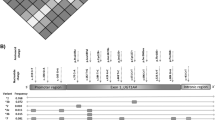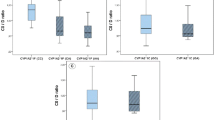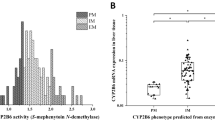Abstract
We aimed to explore the possible influence of CYP2C9 (*2, *3 and IVS8-109 A>T), CYP2C19 (*2, *3 and *17) and ABCB1 (1236C>T, 2677G>A/T and 3435C>T) on phenytoin (PHT) plasma concentrations in 64 Mexican Mestizo (MM) patients with epilepsy currently treated with PHT in mono- (n=25) and polytherapy (n=39). Genotype and allele frequencies of these variants were also estimated in 300 MM healthy volunteers. Linear regression models were used to assess associations between the dependent variables (PHT plasma concentration and dose-corrected PHT concentration) with independent variables (CYP2C9, CYP2C19 and ABCB1 genotypes, ABCB1 haplotypes, age, sex, weight, and polytherapy). In multivariate models, CYP2C9 IVS8-109 T was significantly associated with higher PHT plasma concentrations (t(64)=2.27; P=0.03). Moreover, this allele was more frequent in the supratherapeutic group as compared with the subtherapeutic group (0.13 versus 0.03, respectively; P=0.05, Fisher's exact test). Results suggest that CYP2C9 IVS8-109 T allele may decrease CYP2C9 enzymatic activity on PHT. More research is needed to confirm findings.
This is a preview of subscription content, access via your institution
Access options
Subscribe to this journal
Receive 6 print issues and online access
$259.00 per year
only $43.17 per issue
Buy this article
- Purchase on Springer Link
- Instant access to full article PDF
Prices may be subject to local taxes which are calculated during checkout

Similar content being viewed by others
References
Ngugi AK, Bottomley C, Kleinschmidt I, Sander JW, Newton CR . Estimation of the burden of active and life-time epilepsy: a meta-analytic approach. Epilepsia 2010; 51: 883–890.
García PF, Millán R, Peñaloza Y . Epidemiología clínica de la epilepsia. Rev Mex Neuroci 2010; 11: 82–102.
Quet F, Preux PM, Huerta M, Ramirez R, Abad T, Fragoso G et al. Determining the burden of neurological disorders in populations living in tropical areas: who would be questioned? Lessons from a Mexican rural community. Neuroepidemiology 2011; 36: 194–203.
Martínez-Juárez IE, López-Zapata R, Gómez-Arias B, Bravo-Armenta E, Romero-Ocampo L, Estévez-Cruz Z et al. Epilepsia farmacorresistente: uso de la nueva definición y factores de riesgo relacionados. Estudio en población mexicana de un centro de tercer nivel. Rev Neurol 2012; 54: 159–166.
Thorn CF, Whirl-Carrillo M, Leeder JS, Klein TE, Altman RB . PharmGKB summary: phenytoin pathway. Pharmacogenet Genomics 2012; 22: 466–470.
Seger D 1990 Phenytoin and other anticonvulsants. In: Haddad LM, Winchester JF. Clinical Management of Poisoning and Drug Overdose 2nd (ed). WB Saunders: New York, pp 877–893.
Goldstein JA . Clinical relevance of genetic polymorphisms in the human CYP2C subfamily. Br J Clin Pharmacol 2001; 52: 349–355.
Aynacioglu AS, Brockmoller J, Bauer S, Sachse C, Güzelbey P, Ongen Z et al. Frequency of cytochrome P450 CYP2C9 variants in a Turkish population and functional relevance for phenytoin. Br J Clin Pharmacol 1999; 48: 409–415.
Tate SK, Depondt CH, Sisodiya SM, Cavalleri GL, Schorge S, Soranzo N et al. Genetic predictors of the maximum doses patients receive during clinical use of the antiepileptic drug carbamazepine and phenytoin. Proc Natl Acad Sci USA 2005; 102: 5507–5512.
Taguchi M, Hongou K, Yagi S, Miyawaki T, Takizawa M, Aiba T et al. Evaluation of phenytoin dosage regimens based on genotyping of CYP2C subfamily in routinely treated Japanese patients. Drug Metab Pharmacokinet 2005; 20: 107–112.
Van der Weide J, Steijns LS, van Weelden MJ, de Haan K . The effect of genetic polymorphism of cytochrome P450 CYP2C9 on phenytoin dose requirement. Pharmacogenetics 2001; 11: 287–291.
Hatta FH, Teh LK, Helldén A, Hellgren KE, Roh HK, Salleh MZ et al. Search for the molecular basis of ultra-rapid CYP2C9-catalysed metabolism: relationship between SNP IVS8-109 A>T and the losartan metabolism phenotype in Swedes. Eur J Clin Pharmacol 2012; 68: 1033–1042.
Dorado P, Gallego A, Peñas-LLedó E, Terán E, LLerena A . Relationship between the CYP2C9 IVS8-109 A>T polymorphism and high losartan hydroxylation in healthy Ecuadorian volunteers. Pharmacogenomics 2014; 15: 1417–1421.
Man M, Farmen M, Dumaual C, Teng CH, Moser B, Irie S et al. Genetic variation in metabolizing enzyme and transporter genes: comprehensive assessment in 3 major East Asian subpopulations with comparison to Caucasians and Africans. J Clin Pharmacol 2010; 50: 929–940.
Brøsen K, de Morais SM, Meyer UA, Goldstein JA . A multifamily study on the relationship between CYP2C19 genotype and S-mephenytoin oxidation phenotype. Pharmacogenetics 1995; 5: 312–317.
Sim SC, Risinger C, Dahl ML, Aklillu E, Christensen M, Bertilsson L et al. A common novel CYP2C19 gene variant causes ultrarapid drug metabolism relevant for the drug response to proton pump inhibitors and antidepressants. Clin Pharmacol Ther 2006; 79: 103–113.
Rudberg I, Mohebi B, Hermann M, Refsum H, Molden E . Impact of the ultrarapid CYP2C19*17 allele on serum concentration of escitalopram in psychiatric patients. Clin Pharmacol Ther 2008; 83: 322–327.
Rudberg I, Hermann M, Refsum H, Molden E . Serum concentrations of sertraline and N-desmethyl sertraline in relation to CYP2C19 genotype in psychiatric patients. Eur J Clin Pharmacol 2008; 64: 1181–1188.
Bauer T, Bouman HJ, van Werkum JW, Ford NF, ten Berg JM, Taubert D . Impact of CYP2C19 variant genotypes on clinical efficacy of antiplatelet treatment with clopidogrel: systematic review and meta-analysis. BMJ 2011; 343: d4588.
Luna-Tortós C, Fedrowitz M, Löscher W . Several major antiepileptic drugs are substrates for human P-glycoprotein. Neuropharmacology 2008; 55: 1364–1375.
Hung CC, Chen CC, Lin CJ, Liou HH . Functional evaluation of polymorphisms in the human ABCB1 gene and the impact on clinical responses of antiepileptic drugs. Pharmacogenet Genomics 2008; 18: 390–402.
Siddiqui A, Kerb R, Weale ME, Brinkmann U, Smith A, Goldstein DB et al. Association of multidrug resistance in epilepsy with a polymorphism in the drug-transporter gene ABCB1. NEJM 2003; 348: 1442–1448.
Marzolini C, Paus E, Buclin T, Kim RB . Polymorphisms in human MDR1 (P-glycoprotein): recent advances and clinical relevance. Clin Pharmacol Ther 2004; 75: 13–33.
Allabi AC, Gala JL, Horsmans Y . CYP2C9, CYP2C19, ABCB1 (MDR1) genetic polymorphisms and phenytoin metabolism in a Black Beninese population. Pharmacogenet Genomics 2005; 15: 779–786.
Dorado P, López-Torres E, Peñas-LLedó EM, Martínez-Antón J, LLerena A . Neurological toxicity after phenytoin infusion in a pediatric patient with epilepsy: influence of CYP2C9, CYP2C19 and ABCB1 genetic polymorphisms. Pharmacogenomics J 2013; 13: 359–361.
Ninomiya H, Mamiya K, Matsuo S, Ieiri I, Higuchi S, Tashiro N . Genetic polymorphism of the CYP2C subfamily and excessive serum phenytoin concentration with central nervous system intoxication. Ther Drug Monit 2000; 22: 230–232.
Sullivan-Klose TH, Ghanayem BI, Bell DA, Zhang ZY, Kaminsky LS, Shenfield GM et al. The role of the CYP2C9-Leu359 allelic variant in the tolbutamide polymorphism. Pharmacogenetics 1996; 6: 341–349.
Excoffier L, Lischer HE . Arlequin suite ver 3.5: A new series of programs to perform population genetics analyses under Linux and Windows. Mol Ecol Resour 2010; 10: 564–567.
LLerena A, Dorado P, O'Kirwan F, Jepson R, Licinio J, Wong ML . Lower frequency of CYP2C9*2 in Mexican-Americans compared to Spaniards. Pharmacogenomics J 2004; 4: 403–406.
Dorado P, Berecz R, Norberto MJ, Yasar U, Dahl ML, LLerena A . CYP2C9 genotypes and diclofenac metabolism in Spanish healthy volunteers. Eur J Clin Pharmacol 2003; 59: 221–225.
Dorado P, Sosa-Macias MG, Peñas-Lledó EM, Alanis-Bañuelos RE, Wong ML, Licinio J et al. CYP2C9 allele frequency differences between populations of Mexican-Mestizo, Mexican-Tepehuano, and Spaniards. Pharmacogenomics J 2011; 11: 108–112.
Castelán-Martínez OD, Hoyo-Vadillo C, Sandoval-García E, Sandoval-Ramírez L, González-Ibarra M, Solano-Solano G et al. Allele frequency distribution of CYP2C9 2 and CYP2C9 3 polymorphisms in six Mexican populations. Gene 2013; 523: 167–172.
Hoyo-Vadillo C, Garcia-Mena J, Valladares A, Venturelli CR, Wacher-Rodarte N, Kumate J et al. Association of CYP2C19 genotype with type 2 diabetes. Health 2010; 2: 1184–1190.
Salazar-Flores J, Torres-Reyes LA, Martínez-Cortés G, Rubi-Castellanos R, Sosa-Macías M, Muñoz-Valle JF et al. Distribution of CYP2D6 and CYP2C19 polymorphisms associated with poor metabolizer phenotype in five Amerindian groups and western Mestizos from Mexico. Genet Test Mol Biomarkers 2012; 16: 1098–1104.
Luo HR, Poland RE, Lin KM, Wan YJ . Genetic polymorphism of cytochrome P450 2C19 in Mexican Americans: a cross-ethnic comparative study. Clin Pharmacol Ther 2006; 80: 33–40.
Nastasi-Catanese JA, Padilla-Gutiérrez JR, Valle Y, Ortega-Gutiérrez F, Gallegos-Arreola MP, Figuera LE . Genetic contribution of CYP2C9, CYP2C19, and APOE variants in acenocoumarol response. Genet Mol Res 2013; 12: 4413–4421.
Sosa-Macías M, Llerena A . Cytochrome P450 genetic polymorphisms of Mexican indigenous populations. Drug Metabol Drug Interact 2013; 28: 193–208.
Favela-Mendoza AF, Martinez-Cortes G, Hernandez-Zaragoza M, Salazar-Flores J, Muñoz-Valle JF, Martinez-Sevilla VM et al. Genetic variability of CYP2C19 in a Mexican population: contribution to the knowledge of the inheritance pattern of CYP2C19*17 to develop the ultrarapid metabolizer phenotype. J Genet 2015; 94: 3–7.
Leal-Ugarte E, Gutiérrez-Angulo M, Macías-Gómez NM, Peralta-Leal V, Durán-González J, De La Luz Ayala-Madrigal M et al. MDR1 C3435T polymorphism in Mexican children with acute lymphoblastic leukemia and in healthy individuals. Hum Biol 2008; 80: 449–455.
Vargas-Alarcón G, Ramírez-Bello J, de la Peña A, Calderón-Cruz B, Peña-Duque MA, Martínez Ríos MA et al. Distribution of ABCB1CYP3A5CYP2C19, and P2RY12 gene polymorphisms in a Mexican Mestizos population. Mol Biol Rep 2014; 41: 7023–7029.
Data from HapMap project. NCBI dbSNP. Available at: http://www.ncbi.nlm.nih.gov/projects/SNP/.
Anderson GD . Pharmacogenetics and enzyme induction/inhibition properties of antiepileptic drugs. Neurology 2004; 63: S3–S8.
Johannessen SI, Landmark CJ . Antiepileptic drug interactions – principles and clinical implications. Curr Neuropharmacol 2010; 8: 254–267.
Hung CC, Lin CJ, Chen CC, Chang CJ, Liou HH . Dosage recommendation of phenytoin for patients with epilepsy with different CYP2C9/CYP2C19 polymorphisms. Ther Drug Monit 2004; 26: 534–540.
Odani A, Hashimoto Y, Otsuki Y, Uwai Y, Hattori H, Furusho K et al. Genetic polymorphism of the CYP2C subfamily and its effect on the pharmacokinetics of phenytoin in Japanese patients with epilepsy. Clin Pharmacol Ther 1997; 62: 287–292.
Mamiya K, Ieiri I, Shimamoto J, Yukawa E, Imai J, Ninomiya H et al. The effects of genetic polymorphisms of CYP2C9 and CYP2C19 on phenytoin metabolism in Japanese adult patients with epilepsy: studies in stereoselective hydroxylation and population pharmacokinetics. Epilepsia 1998; 39: 1317–1323.
Ramasamy K, Narayan SK, Shewade DG, Chandrasekaran A . Influence of CYP2C9 genetic polymorphism and undernourishment on plasma-free phenytoin concentrations in epileptic patients. Ther Drug Monit 2010; 32: 762–766.
Maekawa K, Fukushima-Uesaka H, Tohkin M, Hasegawa R, Kajio H, Kuzuya N et al. Four novel defective alleles and comprehensive haplotype analysis of CYP2C9 in Japanese. Pharmacogenet Genomics 2006; 16: 497–514.
Sugimoto K, Uno T, Yamazaki H, Tateishi T . Limited frequency of the CYP2C19*17 allele and its minor role in a Japanese population. Br J Clin Pharmacol 2008; 65: 437–439.
Payan M, Rouini MR, Tajik N, Ghahremani MH, Tahvilian R . Hydroxylation index of omeprazole in relation to CYP2C19 polymorphism and sex in a healthy Iranian population. Daru 2014; 22: 81.
Sanford JC, Guo Y, Sadee W, Wang D . Regulatory polymorphisms in CYP2C19 affecting hepatic expression. Drug Metabol Drug Interact 2013; 28: 23–30.
Kerb R, Aynacioglu AS, Brockmöller J, Schlagenhaufer R, Bauer S, Szekeres T et al. The predictive value of MDR1, CYP2C9, and CYP2C19 polymorphisms for Phenytoin plasma levels. Pharmacogenomics J 2001; 1: 204–210.
Ebid AH, Ahmed MM, Mohammed SA . Therapeutic drug monitoring and clinical outcomes in epileptic Egyptian patients: a gene polymorphism perspective study. Ther Drug Monit 2007; 29: 305–312.
Simon C, Stieger B, Kullak-Ublick GA, Fried M, Mueller S, Fritschy JM et al. Intestinal expression of cytochrome P450 enzymes and ABC transporters and carbamazepine and phenytoin disposition. Acta Neurol Scand 2007; 115: 232–242.
Hennessy S, Leonard CE, Freeman CP, Metlay JP, Chu X, Strom BL et al. CYP2C9, CYP2C19, and ABCB1 genotype and hospitalization for phenytoin toxicity. J Clin Pharmacol 2009; 49: 1483–1487.
Haerian BS, Roslan H, Raymond AA, Tan CT, Lim KS, Zulkifli SZ et al. ABCB1 C3435T polymorphism and the risk of resistance to antiepileptic drugs in epilepsy: a systematic review and meta-analysis. Seizure 2010; 19: 339–346.
Acknowledgements
This research was supported by a grant from Consejo Nacional de Ciencia y Tecnología de México (CONACyT) (#167261). AOV was supported by a scholarship (Doctor’s degree) from CONACyT (#328295).
Author information
Authors and Affiliations
Corresponding author
Ethics declarations
Competing interests
The authors declare no conflict of interest.
PowerPoint slides
Rights and permissions
About this article
Cite this article
Ortega-Vázquez, A., Dorado, P., Fricke-Galindo, I. et al. CYP2C9, CYP2C19, ABCB1 genetic polymorphisms and phenytoin plasma concentrations in Mexican-Mestizo patients with epilepsy. Pharmacogenomics J 16, 286–292 (2016). https://doi.org/10.1038/tpj.2015.45
Received:
Revised:
Accepted:
Published:
Issue Date:
DOI: https://doi.org/10.1038/tpj.2015.45
This article is cited by
-
Meta-analysis of probability estimates of worldwide variation of CYP2D6 and CYP2C19
Translational Psychiatry (2021)
-
Relationships between CYP1A2, CYP2C9, CYP2C19, CYP2D6 and CYP3A4 metabolic phenotypes and genotypes in a Nicaraguan Mestizo population
The Pharmacogenomics Journal (2021)
-
CYP2C9 (*2&*3) and CYP2C19 (*2&*3) polymorphisms among children with nonlesional epilepsy: a single-center study
Acta Neurologica Belgica (2021)
-
Influence of genetic variants and antiepileptic drug co-treatment on lamotrigine plasma concentration in Mexican Mestizo patients with epilepsy
The Pharmacogenomics Journal (2020)
-
Genetic variability among Mexican Mestizo and Amerindian populations based on three ABCB1 polymorphisms
Molecular Biology Reports (2018)



